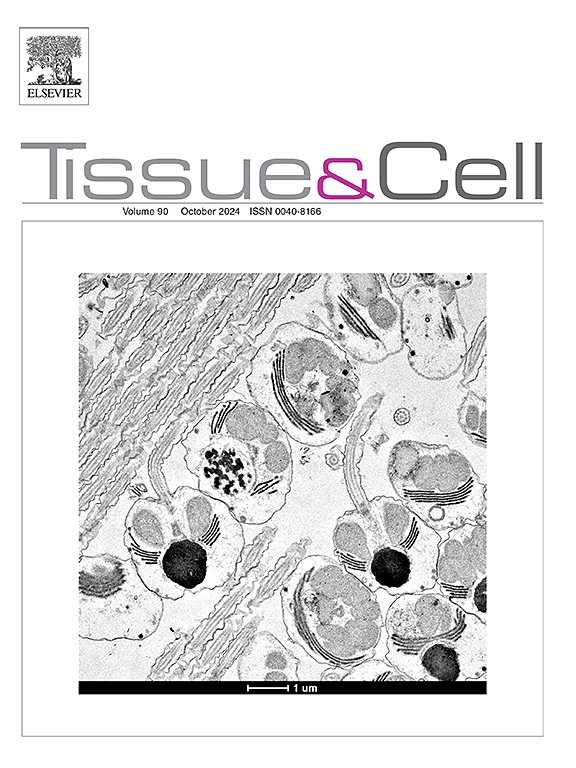The protective effect of Ambrosia maritima versus vitamin D3 against gentamicin-induced acute cortical kidney injury in adult male albino rats: Histological and immunohistochemical study
IF 2.7
4区 生物学
Q1 ANATOMY & MORPHOLOGY
引用次数: 0
Abstract
Gentamicin (GM) is a broad-spectrum antibiotic widely used for severe bacterial infections, but it is associated with acute nephrotoxicity. Ambrosia maritima L. is an annual herbaceous plant that has a variety of medicinal and antioxidant activities. Vitamin D3 is involved in a multitude of biological functions and essential antioxidant pathways. This study aims to investigate the protective effects of Damsissa (Ambrosia maritima) versus vitamin D3 against GM-induced nephrotoxicity using 72 male rats that were randomly divided into six groups: control, Damsissa (100 mg/kg/day), vitamin D3 (1000 IU/kg/day), GM (100 mg/kg/day for 7 days), GM + Damsissa, and GM + vitamin D3. Renal function, oxidative stress biomarkers (MDA, CAT, SOD, GSH), cytokine levels (IL-1β, IL-6, TNF-α, IL-4), and gene expression (Caspase-3, Keap1, PPARγ, Nrf2) were assessed. Histopathological and ultrastructural kidney analyses were conducted using H&E, Masson’s trichrome, PCNA staining, and transmission electron microscopy. Blood samples were tested for renal and liver markers (creatinine, BUN, AST, ALT). Damsissa enhanced survival rates, returned the renal indices to near normal, and ameliorated pathological changes based on immunohistopathological and ultrastructural results. They further reduced pro-inflammatory cytokine production, optimized oxidative stress markers, and normalized gene expression levels. Both treatments exhibited abundant antioxidant and anti-inflammatory effects, which remarkably reduced GM-induced acute kidney injury. These results suggest that both Damsissa and vitamin D3 may exert protective effects against drug-induced nephrotoxicity.
海参对维生素D3对庆大霉素诱导的成年雄性白化大鼠急性肾皮质损伤的保护作用:组织学和免疫组织化学研究
庆大霉素(GM)是一种广谱抗生素,广泛用于严重细菌感染,但与急性肾毒性有关。海棠是一种一年生草本植物,具有多种药用和抗氧化活性。维生素D3参与多种生物功能和必要的抗氧化途径。短句来源本研究将72只雄性大鼠随机分为6组:对照组、丹参(100 mg/kg/day)、维生素D3 (1000 IU/kg/day)、转基因(100 mg/kg/day)、转基因+ 丹参和转基因+ 维生素D3,研究丹参对转基因致肾毒性的保护作用。评估肾功能、氧化应激生物标志物(MDA、CAT、SOD、GSH)、细胞因子水平(IL-1β、IL-6、TNF-α、IL-4)和基因表达(Caspase-3、Keap1、PPARγ、Nrf2)。采用H&;E、马松三色、PCNA染色和透射电镜对肾脏进行组织病理学和超微结构分析。血液样本检测肾脏和肝脏标志物(肌酐、BUN、AST、ALT)。根据免疫组织病理学和超微结构结果,Damsissa提高了生存率,使肾脏指数恢复到接近正常,并改善了病理改变。他们进一步减少了促炎细胞因子的产生,优化了氧化应激标志物,并使基因表达水平正常化。两种处理均表现出丰富的抗氧化和抗炎作用,显著减轻转基因诱导的急性肾损伤。这些结果提示丹草和维生素D3可能对药物性肾毒性具有保护作用。
本文章由计算机程序翻译,如有差异,请以英文原文为准。
求助全文
约1分钟内获得全文
求助全文
来源期刊

Tissue & cell
医学-解剖学与形态学
CiteScore
3.90
自引率
0.00%
发文量
234
期刊介绍:
Tissue and Cell is devoted to original research on the organization of cells, subcellular and extracellular components at all levels, including the grouping and interrelations of cells in tissues and organs. The journal encourages submission of ultrastructural studies that provide novel insights into structure, function and physiology of cells and tissues, in health and disease. Bioengineering and stem cells studies focused on the description of morphological and/or histological data are also welcomed.
Studies investigating the effect of compounds and/or substances on structure of cells and tissues are generally outside the scope of this journal. For consideration, studies should contain a clear rationale on the use of (a) given substance(s), have a compelling morphological and structural focus and present novel incremental findings from previous literature.
 求助内容:
求助内容: 应助结果提醒方式:
应助结果提醒方式:


